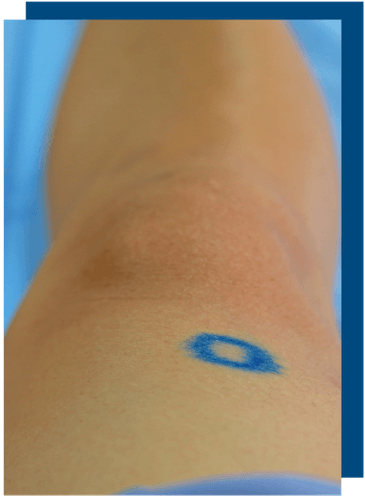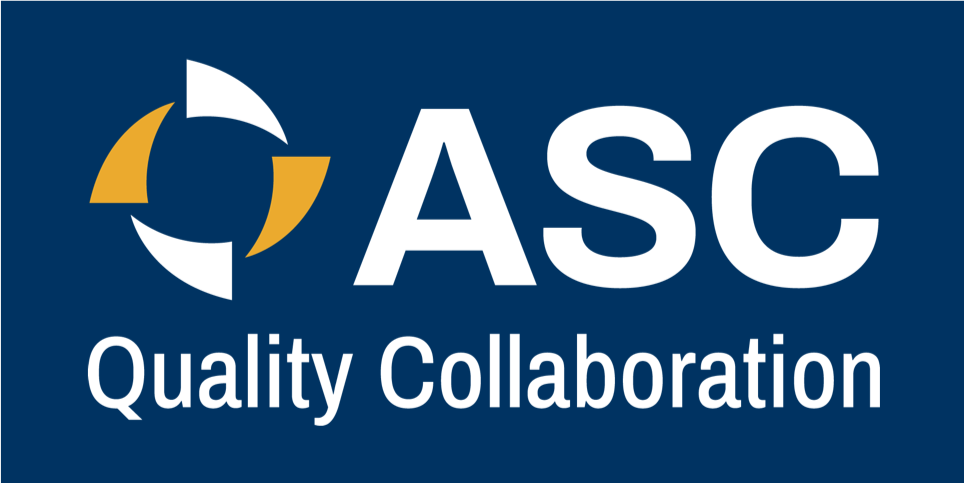Prevention of Wrong Site Surgery Toolkit
The resources in this toolkit may only be used for internal improvement and education efforts. They may not be used for commercial purposes.

The occurrence of a wrong site, side, patient, procedure, or implant during patient care is a serious event.
While the incidence of wrong site surgeries is low, the impact on patient care associated with each incident makes this a priority in ASCs.
The ASC Quality Collaboration has assembled a variety of resources and information that may be used to supplement your current processes to prevent the occurrence of a wrong site, patient, procedure, side or implant event.
The Prevention of Wrong Site Surgery Toolkit contains both essential resources and a broader array of materials, including:
Assessment Tools
- Preventing Wrong Site Surgeries (American Society for Health Care Risk Management) – This tip sheet provides general guidance for the prevention of wrong site surgeries and identifies some of the top causes.
- Procedure/Surgical Safety Gap Analysis – This document adapted from a resource from the American Society of Health Care Risk Management can be used to assess current organizational practices compared to best practices for the prevention of wrong site surgery.
- FAQ Scenarios Wrongs– This document is provided by the ASC Quality Collaboration in an effort to promote consistency of reporting among organizations. The scenarios highlight the need to analyze each case and assign it to the appropriate reporting category.
Implementation Aids
- Universal Protocol and Time Out Policy and Procedure Template – This sample policy and procedure template may be adapted to reflect center-specific services.
- Site Verification and Time Out – This policy and procedure provides an example of processes to verify correct patient, surgical site and anticipated procedure.
- Site Verification and Time Out: GI – This document is an example of a policy and procedure specific to GI endoscopy procedures.
- Procedural Time Out – This sample tool outlines tasks to be completed during the Time Out.
- Block Time Out – This document is an example of processes performed to prevent wrong blocks.
- Pain Management Procedure Time Out – This document provides an example of a Time Out process for pain management procedures.
- Implant Time Out – This tool outlines Time Out tasks specific to general implants, intraocular lens implants, and tissue implants.
- Intraocular Lens Implant Procedures Time Out – This document provides an example of Time Out processes specific to the placement of intraocular lenses.
- Wrong Site, Wrong IOL Checklist – This checklist from the American Academy of Ophthalmology can be used for prevention of wrong site and wrong intraocular lens (IOL) events during ophthalmology procedures.
- Surgical Safety Checklist (World Health Organization) – This Universal Protocol checklist may be modified to fit local practice.
- Surgical Safety Checklist – This checklist includes steps for pain procedures, anesthetic blocks and intraocular lens implants.
- Ophthalmology Surgical Safety Checklist – This checklist includes items specific to ophthalmologic surgery.
- Universal Protocol Flow Chart – This flowchart can be used to document completion of the Universal Protocol and includes “Stops” if processes are not complete.
- Surgeons Office Tips: What You Can Do to Prevent Wrong Site Surgery (Pennsylvania Patient Safety Authority) – This document outlines steps that physician’s offices can take when making referrals to the surgery center to help prevent wrong site surgeries.
Training Materials
- Improving Communication and Teamwork in the Surgical Environment: This training module from the Agency for Healthcare Research and Quality (AHRQ) includes a PowerPoint presentation, facilitator guide, and material use guide.
- Time Out Simulation – This 6-minute video demonstrates the performance of a Time Out in the operating room.
- Prevention of Wrong Site Surgery – Evidence Based Actions: This webinar from the Association of periOperative Registered Nurses (AORN) shares the evidence base for strategies for the prevention of wrong site surgery.
- Doing the “Right” Things to Correct Wrong-Site Surgery: This 12-minute video provided by the Pennsylvania Patient Safety Authority discusses insights into wrong-site surgery.
Monitoring Tools
- Surgical Site Verification Audit Tool – This audit tool can be used to verify the performance of selected processes during surgical site verification.
- Audit Surgical Safety Checklist in the OR: Time Out & Team Briefing – This sample tool from AORN is designed to assess key steps in the implementation of a safe surgery checklist.
- Correct Site and Lens Verification Audit Tool – This audit tool is specific to ophthalmologic surgeries involving the placement of intraocular lenses.

Workplace Reminders
- Time Out Poster – This poster focuses on Time Out as a priority for preventing wrong site surgery.
- Wrong Site Prevention Poster – This poster focuses on five steps to wrong site surgery prevention.
- The Universal Protocol for Preventing Wrong Site, Wrong Procedure and Wrong Person Surgery – This workplace poster provided by The Joint Commission identifies key elements of the Universal Protocol.
Guidelines from Leading Authorities
- Universal Protocol for Preventing Wrong Site, Wrong Procedure, and Wrong Person Surgery™ of The Joint Commission (2024) – These National Patient Safety Goals® from The Joint Commission outline the steps needed to successfully implement the Universal Protocol.
- American College of Surgeons (ACS) Revised Statement on Safe Surgery Checklists, and Ensuring Correct Patient, Correct Site, and Correct Procedure Surgery (2016) – The ACS recommends these guidelines to eliminate wrong site surgery.
- Association of perioperative Registered Nurses Actions to Prevent Wrong-Patient, Wrong-Site, Wrong-Procedure Events (2014) – These action steps from AORN can assist in the development of policies and procedures for the prevention of wrong site surgery.
- Recommendations of the American Academy of Ophthalmology Wrong-Site Taskforce (2014) – These recommendations are designed to minimize the incidence of wrong eye and wrong intraocular lens implant events.
- American Academy of Orthopaedic Surgeons Information Statement: Surgical Site and Procedure Confirmation (2015). This guidance was developed as an educational tool by the American Academy of Orthopaedic Surgeons
- World Health Organization Guidelines for Safe Surgery (2009) – Several of the objectives outlined in these guidelines are pertinent to the prevention of wrong site surgery.
Resources Cited
The materials presented here include donated resources from the members of the ASC Quality Collaboration as well as publicly available resources from the following organizations:
- The Joint Commission (TJC)
- Agency for Healthcare Research and Quality (AHRQ)
- American Society for Health Care Risk Management (ASHRM)
- World Health Organization (WHO)
- Pennsylvania Patient Safety Authority
- Association of periOperative Registered Nurses (AORN)
Comments and other feedback may be directed to Nina Goins, Executive Director, ASC Quality Collaboration.
Contact us today to learn more about how we can support you.
ASC Quality Collaboration
The only organization exclusively dedicated to advancing patient safety and quality of care delivery in ambulatory surgery centers.
